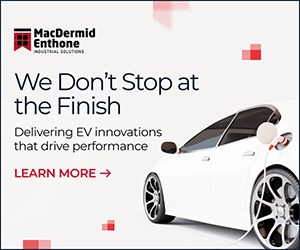The Time is Now
Products Finishing editor-in-chief Scott Francis discusses takeaways from recent industry events and recounts observations about the growing interest in mobility applications.

My adventures over the past month have taken me to several conferences touching on various areas of manufacturing, all with a common thread seeming to run through them — mobility. Whenever I talk about this topic, I feel a bit like I’m walking on eggshells. So many plating operations have dedicated programs that make up a large part of their business that are based on components for traditional internal combustion engine (ICE) vehicles. And I get it. When we look at some of the megatrends in manufacturing, it’s often easier to see the challenges and the obstacles than the potential. The obstacles, the capital investments, the reinventing of processes are the immediate impacts of reimagining any business. It’s much easier to see the impact of such things than to forecast what the opportunities really look like or what they will yield.
Just a few years ago, the idea of a large segment of the driving population embracing EVs seemed unrealistic. Most of the facility owners I would visit would say, “It’ll never happen.” And the reasons why it couldn’t happen were indeed daunting — concerns over the range of battery-powered EVs and the lack of infrastructure to support them remain an obstacle. Yet today, more conversations center around not if EVs will be successful, but instead how to make them successful and how to build the infrastructure to better support them. In 2020, EVs made up 4% of the automotive market share. In 2022, that number jumped to 14%. EVs are expected to surpass 2/3 of global car sales by 2030.
During my early days with PF, I’d ask people about the role they thought coatings and finishes would play in the production of EVs. Many raised a skeptical eyebrow. Today, the conversation is taken quite a bit more seriously. The role finishing technologies play in enabling the evolution of vehicles is an important one, yet the number of engine and powertrain components that EVs need are fewer than those of ICE vehicles. So what will the true impacts be for finishers?
I recently attended the Electroless Nickel Conference in Milwaukee, Wisc., where EN experts, suppliers and applicators were talking about the growing use of EN in EVs and new energy vehicles (NEVs), particularly for enabling conductivity in parts. Hydrogen fuel cell vehicles were also on the minds of many in attendance.
And what about other mobility sectors? The big mobility puzzle is about much more than cars — it's about solving the growing transportation problems that are facing our society. The emerging applications that are out there, from battery-powered EVs to hydrogen fuel cell technology, are all being researched as potential solutions for decongestion of traffic and reducing emissions. From drone-powered delivery services to autonomous freight transportation to flying cars — the way we transport products and move people in our world is changing, and we are quickly finding ourselves at an inflection point.
I recently attended an Advanced Air Mobility Forum and ribbon cutting for the new National Advanced Air Mobility Center of Excellence (NAAMCE) in Springfield, Ohio. The location was selected to facilitate collaboration between the Air Force Research Laboratory (AFRL), the Ohio Unmanned Aircraft Systems Center, NASA, and industry and academia in support of advanced air mobility (AAM) projects, including the development of new electric vertical take-off and landing (eVTOL) aircraft. The ultimate goal is to make the area, which is in close proximity to Wright-Patterson Air Force Base and the AFRL, a hub for AAM R&D activity. The forum’s presentations and panels focused not so much on manufacturing flying cars, freight delivery drones, eVTOLs and air taxis, but instead around building the infrastructure and creating operations procedures, air traffic guidelines and training programs for this new class of aircraft.
Perhaps if you’re working in manufacturing, you’re already paying attention to this trend and the prototype vehicles that are currently working toward flight certifications. But, to many in the general public, flying cars are still the stuff of The Jetsons or Bladerunner. But this new class of aircraft does exist and the Department of Defense and federal and state regulatory agencies are all participating in ways to make the technology a real part of our world. How will finishers be involved in the components and electrical systems for these aircraft as well as the supporting infrastructure?
We’re living in a time filled with collaboration and innovation — now is the time to get involved with these applications if you haven’t already. The “future” is now.
Related Content
Ecoat — An Entrepreneurial Approach
Job shop style approach for a captive ecoat line encourages ownership, innovation.
Read MoreCoatings Plant Evolves with Market Trends
Expanding its focus from exclusively serving the RV industry, one of this company’s stand-alone coatings plant has successfully extended its services to additional markets.
Read MoreTitrations: To Automate or Not to Automate?
What considerations should you keep in mind for automatic titrations? Conor McAnespie of Hanna Instruments discusses the benefits of auto titrators.
Read MoreRead Next
The 2024 Ford Mustang: All the Colors Available
Although Chevrolet has announced the end of the Camaro and Dodge is offering “Last Call” editions of the Charger and Challenger, the Ford Mustang is launching to its seventh generation.
Read MoreEpisode 42: An Interview with Robin Deal, Hubbard-Hall
Hubbard-Hall wastewater treatment specialist Robin Deal discusses the latest trends in wastewater management.
Read MorePowder Coating 4.0: Smarter, Faster, More Efficient and Connected
New tools reduce cost and waste, lower manufacturing footprint of powder coating operations.
Read More


























